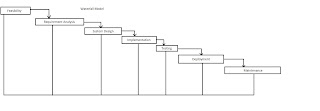Software Development Process Models
1.Waterfall Model
This was the first process model and it is very easy to
understand and use. In this model, you should finished the previous phase
completely and moving to next phase. At the end of each phase, there is a
testing to know whether the project is going right way or not. After this
testing, the project is decided to continue or discard.
This type use for,
- Small and permanent projects
- Clear requirements
- Static technology
- Enough resource and expertise
Advantages
- Easy to understand and use
- Easy to manage
- Phase complete at one time
- Quality and cost control for each step
- Separation of tasks
- Process appearance
Disadvantages
- Cannot go back
- Not suitable for complex, long and on-going projects
- High risky and unclear
2.Evolutionary Development Model
In this model, there are many Software Development Life
Cycles. Each cycle has a feedback from customer. Here develop the core module
first and build next modules on that.
Uses
- For large projects
- Project which can divide into module
Advantages
- Output is tally with customer ideas because always connect with customer
- Can provide versions quickly
Disadvantages
- Cannot use for small projects
- Requirement should be clear
3.Reuse Oriented Development Model
This model use to develop projects which are updated
versions. This reuse technology conduces to build higher quality and
reliability system.
Advantages
- Using reuse model avoid extra-cost for remaking the system to add new features.
- Save the time because each phase builds on the previous phase which has already been successes.
- Can minimize the likelihood errors or bugs in the final project
- Requirements are known because using the previous software.
Disadvantages
- Have to design some new program components to develop the software.
- Final product doesn't complete with all the requirements of users.





Comments
Post a Comment